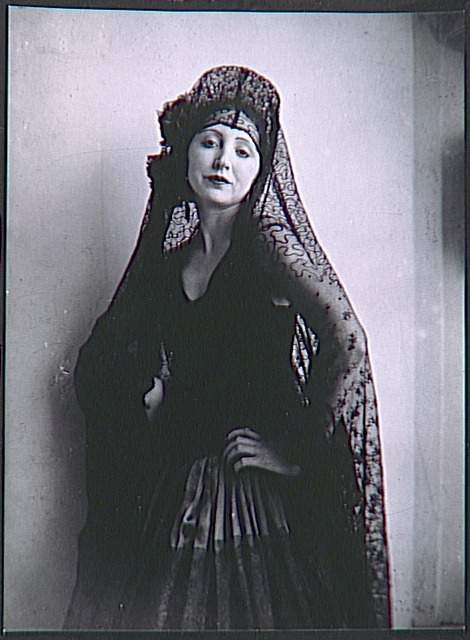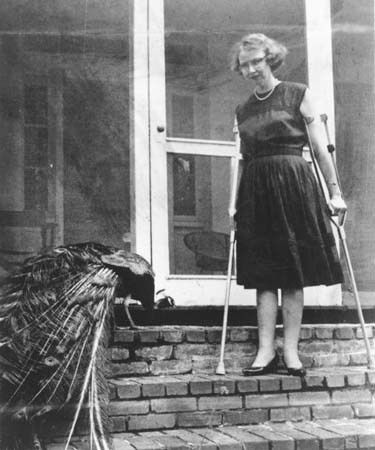Bad Bitches in the Canon
What if Anaïs Nin and Flannery O’Connor had been friends?


“Lila appeared in my life in first grade and immediately impressed me because she was very bad.” -Elena Ferrante, ‘My Brilliant Friend’
The writers Anaïs Nin and Flannery O’Connor both hit milestones in the 1950s: O’Connor won a whole bunch of literary awards, and Nin married her second husband, (twenty years her junior) while still married to her first. The former was thwarted only by lupus, the latter by the IRS, which would not let both husbands claim her on their tax returns. Such is the life of a literary bad bitch.
Nin is famous for her unexpurgated memoir Henry and June, which details her 1931–2 sexual obsession with the American writer Henry Miller and, now and then, his wife June (who appears in the flesh for about two paragraphs). About three fucks out of every ten thousand, Henry and/or Anaïs wonders if they’re together because they cannot be with June. She is the parmesan to their pasta — what O’Connor, in her letters, would spell as cheeze — but never the main dish. Nin’s memoir should have been titled Henry and…Where’d she go? NY? Oh well. As for O’Connor, well, even Esquire lists her on their predominantly male must-read list. She’s right up there — a few spots ahead of Henry Miller.
The funny thing is, Anaïs Nin is not on that list, even though she was all over Henry Miller. Most people — and by ‘most people,’ I mean ‘most woefully inexperienced freshman English majors,’ by which I mean ‘myself, once’ — read Anaïs Nin to learn how artists love, if not how to be an artist in love. And then they go into therapy.
That 2015 Esquire list caters to men, which is most of what Nin does. Here’s a hot slice: “Last night in my sleep I touched Hugo’s penis as I learned to touch Henry’s. I caressed it and pressed it in my hand. In my half-sleep I thought it was Henry. When Hugo became excited and began to take me, I awakened fully and was deeply disappointed. My desire died.”
Who’s Hugo? Just Nin’s banker husband, out of whose clothing-allowance she funds Henry’s stay in Paris. Nin had slept with one of Hugo’s associates, before sleeping with her cousin Eduardo, which was before (or while?) she slept with Henry, and definitely before she saw and seduced Eduardo’s therapist, after which she sent Hugo to see said therapist. Bad bitch? Her trophy is in the mail, my friends.

Much has been made about female friendship in literature these days, and all of it has made me wonder: what about the writers who could have been or should have been or who — HELL — just had friends? Nin wrote Henry and June when she was approaching 30 in the ’30s. She was a cool twenty years O’Connor’s senior and, when not in Europe, only lived on the American coasts. Aside from stints in Iowa, NYC, and Connecticut, O’Connor stuck it out in Milledgeville, Georgia for most of her life. But if Nin and O’Connor had been in primary school in the US at the same time (alternate reality, I know, but hang with me), then CLEARLY they would have been seated next to each other. WHICH MEANS THEY WOULD HAVE BEEN FRIENDS. Eventually. At some point. Because geography is destiny. Have you not seen “Freaks and Geeks?”
Sister act: female friendship in fiction from Woolf to Ferrante and Zadie Smith
Here’s how Nin and O’Connor were so different that they would have HAD to have been friends: Nin had beauty, luxury, Europe, and “lying soldered for four days” at a time with Henry Miller. O’Connor was swollen with lupus, raised peacocks to get by, and once travelled to Europe on a pilgrimage with Regina (her mother). Nin deified Miller; O’Connor, God. Nin risked surgery so she could “forever efface the humorous tilt of [her] nose”; O’Connor got steroids so she could stand up.
And yet, O’Connor had something Nin did not, besides success as a fiction writer. What Nin needed more than any night of boning Henry Miller was to hang out with a person who could laugh at her and with her, who wasn’t trying to sleep with her, who wasn’t using her for her husband’s money, who read her writing for what it was instead of what it wasn’t. What her writing is, for the record, is fucking brilliant.
Nin’s biggest reader, and thereby biggest critic, was Henry Miller. Nin showed him her diaries as she was writing them, so that even when she was writing about what he thought about her writing, she was vying for his approval. One of her proudest (and saddest) moments comes when “Henry says I write like a man, with tremendous clearness and conciseness.” (Hear that? It’s the silence of a bajillion women, who should be writing as the people they are, not the people they can never be — people who are, by the way, not so very “clear” or “concise.” Take a little peek at Tropic of Cancer if you don’t believe me.)
Nin’s reliance on Miller’s approval would have stuck in O’Connor’s craw had they actually known each other. O’Connor knew of Nin, and there was definitely something about Nin that bothered her, as she wrote to a friend: “The last issue [of The Village Voice] had an interview with Anaïs Nin in it which nearly made me throw up.” Something else that made O’Connor want to vomit was people who talked about “The Struggles and Loneliness of the Writer.” Much of O’Connor’s income came from speaking engagements at colleges, and she bristled at the stereotypes and limitations imposed on her. In a 1956 letter, she referred to another (unnamed) female writer who had told their shared audience that “we must be better sweethearts wives & mothers.” O’Connor made clear that she’d prefer that mandate than to be told how lonely she was in her struggle as a writer.
You could tell O’Connor how to be a woman and she’d keep her food down, but woe to the individual who dared tell her how to be an artist. O’Connor’s mother, Regina, supported her but did not understand her: “The other day she asked me why I didn’t try to write something that people liked instead of the kind of thing I do write. Do you think, she said, that you are really using the talent God gave you when you don’t write something that a lot, a LOT, of people like? This always leaves me shaking and speechless, raises my blood pressure 140 degrees, etc. All I can ever say is, if you have to ask, you’ll never know.”
Nin had her own unanswered questions, such as: “Could Hugo be made more sensual? It lasts so short a time with him. He thinks himself a phenomenon because he took me six nights in succession, but with quick, stabbing movements.” Girl — if you have to ask…
And right there is the greatest gift Flannery O’Connor could have given: laughs. Anaïs Nin had all of the sex, but she had none of the laughs — and no friends. Was June Miller a friend? June Miller made a spectacle of promising sexual favors to a ticket salesman because she had blown Nin’s clothing allowance on perfume for a friend other than Anaïs. With friends like that, who needs friends?

Flannery O’Connor, on the other hand, was a friend for life. Referring to her buddies at the Yaddo Writer’s Colony, perhaps specifically Robert Lowell, O’Connor wrote, “I was too inexperienced to know he was mad, I just thought that was the way poets acted.” You catch that? She was Catholic and, because she was Catholic (or perhaps just polite), she left the judging to God.
O’Connor couldn’t go to visit her friends as much as she would have liked (see: lupus), but her collected letters tally nearly 600 pages of teeny tiny print. As the brilliant Hilton Als will tell you, there were many more writers Flannery O’Connor should have befriended, but she was loyal to those she had. And she was funny as hell. In response to a comparison between her own writing and that of another Catholic, Graham Greene, O’Connor explicates that “If Greene created an old lady, she would be sour through and through and if you dropped her, she would break, but if you dropped my old lady, she’d bounce back at you, screaming, “Jesus loves me!” I think the basis of the way I see is comic regardless of what I do with it.”
This Lonesome Place – The New Yorker
Unbreakable old ladies, screaming Jesus loves me! O’Connor could have taught Nin to laugh at the men who told her what and how to be. Perhaps O’Connor could have benefited from Nin’s perspective in return. In a rare moment of vulnerable reflection, O’Connor acknowledges
…sickness is a place, more instructive than a long trip to Europe, and it’s always a place where there’s no company, where nobody can follow…Success is almost as isolating and nothing points out vanity as well. But the surface hereabouts has always been very flat. I come from a family where the only emotion respectable to show is irritation. In some this tendency produces hives, in others literature, in me both.
When Nin was “down in the dumps,” she “would clamber out again to good coffee on a lacquered tray beside an open fire. Each time I would clamber out to silk stockings and perfume. Luxury is not a necessity to me, but beautiful and good things are.”
O’Connor did not have lacquered trays or silk stockings (she didn’t even specify whether her beloved sweater from Italy, sent by friends, was cashmere; perhaps because she didn’t know), but she would have loved Nin’s perfume, Narcisse Noir by Caron. Favored also by Gloria Swanson, the scent has notes of orange blossom, bergamot, petitgrain, lemon, rose, jasmine, jonquil, narcissus, musk, vetiver, civet, and sandalwood. In short: everything good and soothing and sensual.
O’Connor once wrote to a friend: “Do you read the National Geographic or do you smell it? I smell it. A cousin gave me a subscription when I was a child as she noted I always made for it at her house, but it wasn’t a literary or even a geographical interest. It has a distinct unforgettable transcendent apotheotic and very grave odor. Like no other mere magazine. If Time smelled like the Nat’l Geo. there would be some excuse for its being printed.”
These two writers, polar opposite as they may seem, were both sensualists: O’Connor inhaling the National Geographic, resplendent among her peacocks, and Nin, bathing in Narcisse Noir, among that other sort. Bad bitches, indeed.
Olivia Ciacci is a graduate teaching fellow at Columbia University, where she is writing a novel for her MFA in Fiction.